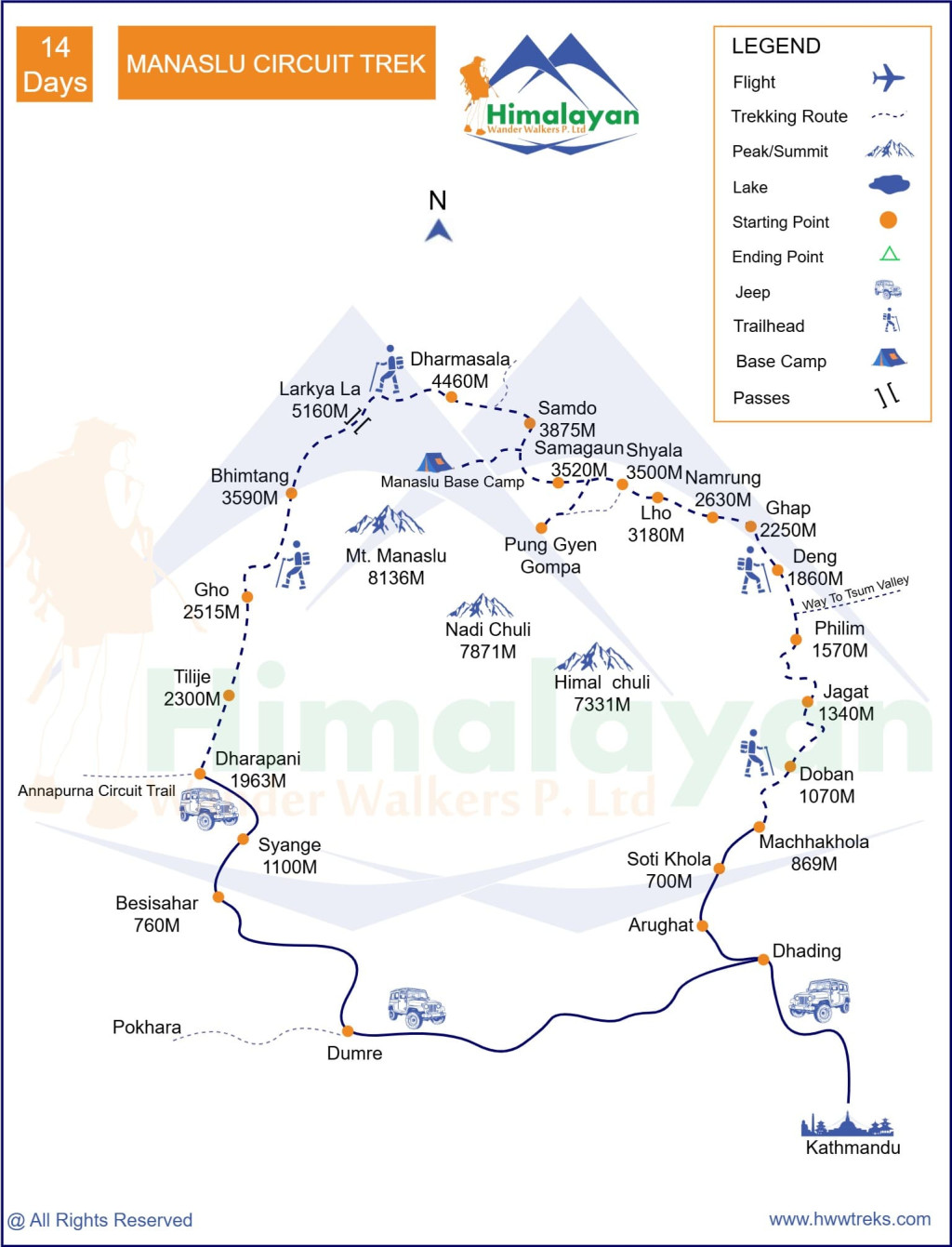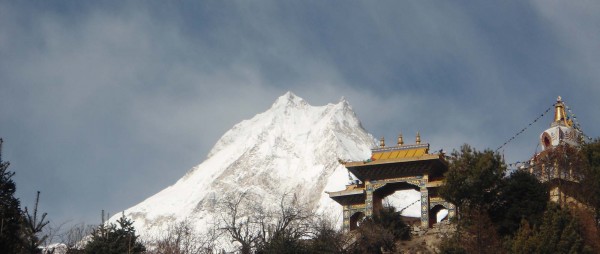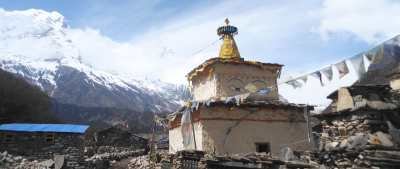Important Information
Region
Manaslu Region Treks
Duration
13 Days
Max Altitude 5160m
Best Season March - November
Activity Per Day
5-6 hrs
Grade
Level 3
Group Size
2 - 12 people
Transportation Jeep
Explore the sensational view of Nubri Mountains including Mount Manaslu (8th highest mountain in the world with 8,156m), Tibetan immigrant culture, and experience the dramatic Larke Pass of 5,100 meters.
Manaslu Circuit Trekking, one of the best treks in Nepal regarded by many trekkers. Manaslu circuit trek can be easily done in a tea house style without the expensive camping trip. This trek comprises from sub-tropical Himalayan foothills to arid Trans Himalayan high pastures bordering Tibet and offers an astonishing view, increasingly mountainous landscape including a high pass crossing at Larke La. This trek is both geographically and culturally extraordinary. The residents of Nubri (the western mountains), a region known for Upper Buri Gandaki, are Tibetan immigrants decades ago. They have their own spoken language, dress, and customs which are almost nearly Tibetan. There is still continuous trade between Nubri and Tibet, for instance, Chinese beer and candies are found more frequently than Nepali ones. In this region Tibetan culture and religion have a strong influence, most places have Tibetan names with the meaning behind every name. The trekking route follows the ancient salt trading route along the Budhi Gandaki River. Trekking through the green forest, several gorges, beautiful waterfalls, typical villages, centuries-old monasteries, and the turquoise lake (Birendra Tal)
This trek was officially opened to tourists in 1991AD, but mountaineering expeditions had long access to the area. In 1950 a party led by HW Tilman trekked from Tilje to Bimtang and Colonel Jimmy Roberts crossed the Larke La Looking for an interesting mountain to climb. Mount Manaslu was attempted by Japanese expeditions every year from 1952 until 1956 when the first ascent was made. It thus became known as a "Japenese Mountain", and much of the information about this particular area was available only in Japan. Japanese continued to dominate the climbing scene in Manaslu until 1971.
We the Himalayan Wander Walkers are waiting for you to serve in this region, we organize groups of two trekkers and up in either camping or teahouse treks. The best season for the Manaslu trek is from March - November.
Highlights of the Manaslu Circuit Trek:
- Scenic dirt road driving to Arughat from Kathmandu
- Exploring the Budhi Gandaki River valley
- Walking between the borders of Nepal and Tibet
- Experience the Nepalese and Tibetan mixed culture
- Crossing Larkya La over 5106 meters
If you are looking for a different itinerary than the itinerary here, please Customize Your Trip.
Include
Transport from Kathmandu to Machakhola and dharapani to Kathmandu by local bus/jeep sharing .
Tea House/lodge accommodation during the trek.
2Night accommodation in 3* hotel with breakfast in Kathmandu.
All Standard Meals (Breakfast, Lunch, and Dinner) during the Trek.
Official Himalayan wander walkers (Government registered and licensed) Expert Guide, 1 Assistant Guide Above 5 people in a group
Trekkers with accompanying porters (generally, 1 porter per 2 trekkers) to assist with carrying gear during the trek. (We cover the porters’ meals, lodging, salary, transport, insurance, equipment, and other essentials.)
Manaslu special permit $100 per person
All Government and local taxes.
Arrangement of emergency evacuation service (should have insurance for emergency evacuation and will be paid by your travel insurance company)
Farewell Dinner in Kathmandu before your international departure.
Manaslu and Annapurna Conservation Permit (MCAP & ACAP)
Exclude
International flight airfare
Excess baggage charges
Meals (meal and dinner) in Kathmandu
Extra night accommodation in Kathmandu due to early arrival, late departure, early return from trekking.
Personal expenses such as shopping, snacks, bar bills, bottle or boiled water, shower, Wi-Fi, laundry, telephone call, battery re-charge fee extra porters, etc.
Personal clothing and gear
Travel insurance
Tips for guide and porters
Additional costs or delays caused by out of management control, for example, landscape, weather condition, itinerary modification due to safety concerns, illness, change of government policies, strikes, etc.
Everything not mentioned in the include section
Route Map

Important Information
CHECKLISTS FOR MANASLU CIRCUIT TREK
- Valid passport (valid for six months from the date of your trip)
- MasterCard, Visa Credit, and Debit Cards are accepted in Nepal. However, some cash is highly recommended.
- Mobile (if your cell phone is from CINGULAR USA or ATNT (USA) operators, then your cell phone will work in Nepal.)
- Clothing (Layered clothes, windproof and waterproof jackets, fleece pullovers, thermal base layers, hiking pants, shorts, headwear, footwear, and other items according to your needs)
- Personal Items and Toiletries (First-Aid Kit, Iodine tablets or a UV purifier to treat water, Sun Protection)
- Travel and Health Insurance
- Trekking gear and equipment(if you have your own trekking gear and equipment, such as trekking poles, sleeping bag, and shoes, then you can bring them; else you can rent them in Thamel, Kathmandu). Read more for trekking gears and peak climbing gears.
Guiding, Food, and Lodging
In Nepal, all trekking supplies - Teahouse trekking means staying and eating in local lodges. We stay in single rooms where possible, but often you will have to share. The rooms are basic, normally just a bed with a pillow, blankets. A few have electric lights and all have a spacious dining room-lounge. We eat at teahouses and, although the food is usually plentiful and delicious, the menu is not extensive. They offer a variety of potatoes, rice and noodle dishes, as well as soup and seasonal vegetables. Beers and local spirits are often available, but that will be at your own cost. A variety of cereals, bread, and egg dishes are generally available for breakfast. There are also snacks available such as basic biscuits, chocolate, and soft drinks and in some areas, you will find fresh fruit in season. It is normal to meet your porter in the teahouse where you will stay overnight. So, pack your necessary things in your own day pack.
DRESS CODE FOR VISITING MONASTERIES, AND TEMPLES IN NEPAL
Doing treks in Himalayas of Nepal is a distinct culture and environment. Trekkers need to consider on following do’s and don’ts.
- Shirt (either half or full sleeve)
- Full pants/long skirts
- Any type of shoes with socks
- No Hats, No Umbrella, No Slippers, No t-shirts, No short skirt, and No half-pants
- Photographs allowed in the courtyard only.
Note regarding itineraries
Although we generally adhere to the schedule, the itinerary is subject to change for numerous reasons beyond our control, including weather and terrain conditions, suitable campsite availability, and the group's general fitness level. It is important to understand that our trek is logistically complex and it is not unusual that adjustments be made. Our guide will orient you each evening to the following day's plan; their good judgment is the key to the long history of successful treks that Himalayan Wander Walkers has led till now. Please remember that our ability to make adjustments as needed helps to ensure that your trek is successful.
Frequently Asked Question
Yes, you can customize the Manaslu Circuit Trek. Depending on your preferences, we can adjust the itinerary to suit your needs, such as shortening or lengthening the trek or adding extra days for rest. Just let us know your preferences: “Customize Your Trip."
The trek is moderately difficult, with high-altitude challenges like the Larkya La Pass (5106 m). It's suitable for trekkers with some experience in mountain trekking or those who can train and keep fit before the trek.
Yes, a guide is required for the Manaslu Circuit trek as it passes through remote areas. A guide also enhances your cultural and natural experience and provides you with a sense of security. Read more about trekking guides and porters in the Manaslu Region.
Yes, for Manaslu Circuit Trek, the trekkers need four permits: a Manaslu Restricted Permit Area Permit, a Manaslu Conversation Area Permit, an Annapurna Conservation Area Permit, and an Entrance Fee from the local government. For detailed information regarding these permits, read our Manaslu Area Permits and their Costs.
Yes, you might get altitude sickness during the trek since we will be at an elevation of 5106 meters (Larkey La Pass). Altitude sickness is a common concern when trekking in high-altitude regions, and we take it seriously. To mitigate the risk, we have built-in acclimatization (rest) days into the itinerary, allowing your body to adjust gradually to the changing elevation. Staying hydrated, eating well, and taking things slow are keys to avoiding altitude sickness. If symptoms like headaches, nausea, or dizziness appear, we encourage resting and informing your guide, who will follow proper protocols.
Yes, there is internet access during the Manaslu Circuit Trek. NTC and Ncell SIM cards work in the lower region, with NTC being more reliable. Many teahouses offer Wi-Fi for a fee. It's recommended to buy an NTC SIM card in Kathmandu. While power is available in most villages, a spare battery is advised due to occasional outages at higher altitudes. Read more about internet access in the Manaslu Region.
For the trek, the essentials include sturdy trekking shoes, warm clothes, a sleeping bag, water bottles, sunscreen, a hat, and a small first-aid kit. Be sure to pack light but adequately for the weather conditions and trek duration. For more details regarding trekking gear and equipment, read our Trekking Gears blog.
No questions found matching your search. Try different keywords or browse all questions above.
| {{type.min}} - {{type.max}} Pax {{type.name}} - {{type.desc}} | {{type.display_price}} per people |
Extra prices:
Let us help you decide Inquiry
You might also like

- 23 days
- Manaslu Region Treks
Manaslu Circuit with Tsum Valley
Tsum valleys and Manaslu Circuit used to trek only with proper camping equipment in the past. But these days tea houses are built there to provide lodging and fresh meal service to trekkers and mountaineers who wish to visit these hidden valleys of Manaslu and Tsum that lie in Gorkha district. ...


